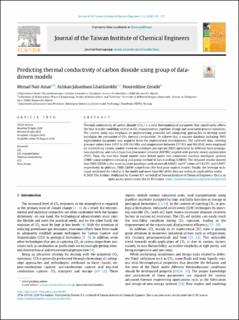| dc.contributor.author | Nait Amar, Menad | |
| dc.contributor.author | Jahanbani Ghahfarokhi, Ashkan | |
| dc.contributor.author | Zeraibi, Noureddine | |
| dc.date.accessioned | 2021-03-17T05:48:44Z | |
| dc.date.available | 2021-03-17T05:48:44Z | |
| dc.date.created | 2020-08-21T14:26:54Z | |
| dc.date.issued | 2020 | |
| dc.identifier.issn | 1876-1070 | |
| dc.identifier.uri | https://hdl.handle.net/11250/2733777 | |
| dc.description.abstract | Thermal conductivity of carbon dioxide (CO2) is a vital thermophysical parameter that significantly affects the heat transfer modeling related to CO2 transportation, pipelines design and associated process industries. The current study lays emphasis on implementing powerful soft computing approaches to develop novel paradigms for estimation of CO2 thermal conductivity. To achieve this, a massive database including 5893 experimental datapoints was acquired from the experimental investigations. The collected data, covering pressure values from 0.097 to 209.763 MPa and temperature between 217.931 and 961.05 K, were employed for establishing various models based on multilayer perceptron (MLP) optimized by different back-propagation algorithms, and radial basis function neural network (RBFNN) coupled with particle swarm optimization (PSO). Then, the two best found models were linked under two committee machine intelligent systems (CMIS) using weighted averaging and group method of data handling (GMDH). The obtained results showed that CMIS-GMDH is the most accurate paradigm with an overall AARD% and R2 values of 0.8379% and 0.9997, respectively. In addition, CMIS-GMDH outperforms the best prior explicit models. Finally, the leverage technique confirmed the validity of the model and more than 96% of the data are within its applicability realm. | en_US |
| dc.language.iso | eng | en_US |
| dc.publisher | Elsevier | en_US |
| dc.rights | Navngivelse 4.0 Internasjonal | * |
| dc.rights.uri | http://creativecommons.org/licenses/by/4.0/deed.no | * |
| dc.title | Predicting thermal conductivity of carbon dioxide using group of data-driven models | en_US |
| dc.type | Peer reviewed | en_US |
| dc.type | Journal article | en_US |
| dc.description.version | publishedVersion | en_US |
| dc.source.journal | Journal of the Taiwan Institute of Chemical Engineers | en_US |
| dc.identifier.doi | 10.1016/j.jtice.2020.08.001 | |
| dc.identifier.cristin | 1824518 | |
| cristin.ispublished | true | |
| cristin.fulltext | postprint | |
| cristin.qualitycode | 1 | |

